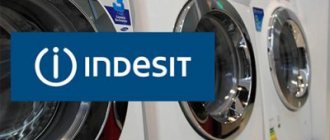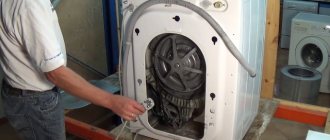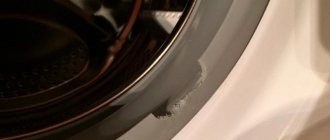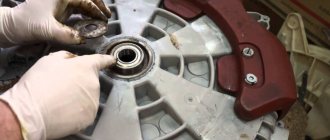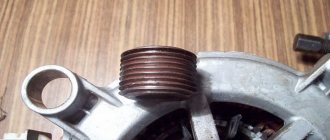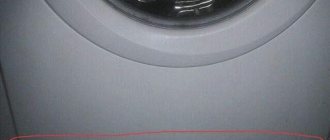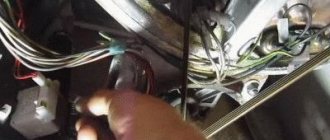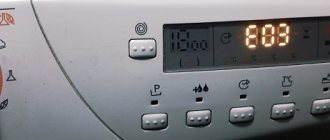One of the most important parts in a washing machine is the tank. A faulty tank can cause damage to other parts of the machine. The quality and durability of the tank depend on the material from which it is made. Before purchasing, it is advisable to familiarize yourself with what material served as the basis for creating the tank. To do this, just move the rubber of the hatch a little. If you need washing machine repair in Saratov or Engels, call our company. We will produce it as quickly and efficiently as possible.
Polymer tanks
Well-known brands of washing machines use their own designs to create tanks. Basically, these are polymers with various additives. Each washing machine manufacturer carries out its own developments and names its polymer substance. Tanks made of composite materials can last about 30 years , they are reliable and durable. The composition of polymer tanks ensures their resistance to chemicals. It is necessary to take into account that due to the lower price of a polymer tank, you can purchase a washing machine in an affordable price category.
Practical studies have shown that in terms of their physical properties, polymer tanks are significantly superior to metal tanks. Basically, these are hard materials that are resistant to high temperatures and alkalis and do not absorb moisture.
The weak point of all polymers is random objects that can get into the tank - buttons, nails and bolts. To extend the life of your washing machine, it is advisable to carefully check your clothing pockets before loading them. Polymer tanks are easier to repair.
What is Polynox?
Polynox is not so much a new material as a more euphonious name for polypropylene with special chemical additives. It is used in the manufacture of washing machine tanks. Polynox tanks are quite popular for a number of reasons. Firstly, this material is cheap, which reduces the cost of washing machines. Secondly, it is quite easy to process. Thirdly, polynox tanks have better characteristics than stainless steel tanks.
On a note! Polynox is cheaper than stainless steel. Washing machines with tanks made from it are cheaper.
Polynox and other plastic options
Polynox is often used in Bosch washing machines. But other manufacturers also use analogues of this material. The most popular analogue is polyplex. It is not afraid of rust, strong vibration and other disadvantages of metals. But it is still fragile compared to other plastic analogues.
Electrolux tanks are made from Carboran, which is a more durable but expensive plastic, which is reflected in their cost. Carboran is the company’s own development. In addition to increasing strength, Electrolux made sure that their plastic did not absorb odors, had better thermal insulation qualities and sound insulation. In addition, Carboran is not afraid of aggressive chemicals.
Kandi prefer to use Silitek, which is essentially a complete analogue of Polynox with a number of minor differences. It is not afraid of acidic and alkaline environments.
Pros and cons of tanks from Polynox
Manufacturers, in pursuit of lower prices for washing machines, began to produce plastic tanks. On the one hand, buyers are happy about this price reduction, but on the other hand, they have doubts about the durability and reliability of such tanks. Let's first look at the obvious advantages of plastic tanks:
- Plastic tubs are less susceptible to vibration during washing. This reduces the noise level of the washing machine.
- Polynox tanks retain heat inside better, meaning the water does not need to be constantly heated. This reduces the washing machine's energy costs for heating water.
- Plastic is much lighter than metal, which reduces the weight of the washing machine. This makes it easier to transport.
- Polynox will not be damaged by moisture and will not rust. This increases the period of its use.
- As mentioned above, Polynox is cheaper than stainless steel. Cars with plastic tanks are cheaper than their counterparts with metal ones.
There are many advantages, but there are no disadvantages:
- Plastic is easier to damage. Therefore, if a stainless steel tank survives the impacts of solid foreign objects that fall into the tank along with your clothes during washing, then Polynox may crack during the next impact at high speeds.
Important! If your washing machine has a plastic tank, check the items carefully. Hard and sharp fittings can damage it!
- In addition, during self-repair or coastal transportation, plastic tanks can also suffer from impacts.
But manufacturers are aware of this disadvantage and are improving the plastic formula. Modern washing machines increasingly use much stronger plastic than their recent predecessors.
Polyplex tanks
If the tank material is polyplex , then you can count on the machine’s resistance to high temperatures, corrosion and chemicals. Like any other composite materials, polyplex absorbs vibration well, thereby increasing the soundproofing properties of the machine.
The high thermal conductivity of the material contributes to more economical energy consumption. Also, polyplex tanks are among the cheapest.
The disadvantages of polyplex include fragility, especially at low temperatures. See also: What to do if the washing machine does not spin the drum.
Plastic tanks
The motivation of a manufacturer seeking to reduce the cost of washing machines is understandable. The lower the cost, the lower the final cost of the product, which means the product becomes more attractive to the consumer and is purchased more often. But what kind of car will it be, in which such an important part as the tank is made of plastic? Will it be reliable and durable? To answer these questions, let’s look at the pros and cons of plastic tanks and, according to tradition, start with the pros.
- The plastic vibrates less, which means the washing machine makes less noise during operation.
- A plastic tank has less heat transfer, which means the water heated in it for washing remains hot longer.
- Plastic is a lightweight material, which means a car with plastic parts will be lighter.
- Polynox does not rust or rot from moisture, in this sense its durability is beyond doubt.
- Polynox is much cheaper than metal, so if you buy a washing machine with a plastic tank, you immediately save up to 8% of its cost.
Plastic tanks have not only advantages, but also disadvantages. The main disadvantage is relatively lower resistance to mechanical damage. Washing machine repair specialists often find that plastic tubs crack from impacts. They are often damaged by users when repairing the washing machine themselves (they pierce them with a screwdriver or drop a concrete counterweight onto the tank). Repairing your washing machine tank can be quite expensive later on.
Fortunately, manufacturers are constantly working on the formulas of the plastics they use in the production of washing machines, so the most modern washing machine already has a much more durable tank.
In 3-5 years, machines with plastic parts will not be inferior in durability to a washing machine with a stainless steel tank.
Metal tanks
High-quality stainless steel is a traditional, long-proven material for a washing machine tank. Just look at the old Soviet-made semi-automatic washing machines, which are now lying around in almost every garage or shed. The car has not been working for a long time, but its stainless steel tank continues to live and, moreover, it looks like new. Durability is not the only advantage of a stainless steel tank.
- Steel tanks are extremely durable and resistant to mechanical damage.
- Such tanks are not afraid of almost any aggressive chemicals and high temperatures.
- Due to dampness, mold and mildew do not form on them, and microbes also multiply less on them.
Metal tanks also have many disadvantages. The main disadvantage is the high cost and the higher quality the steel, the more expensive the tank. Metal tanks have significantly higher heat transfer, which means the water in them will cool faster and require more energy to heat it. Also the scourge of metal tanks is vibration. When the drum rotates quickly, the tank will also clang quite loudly, so you can’t dream of a quiet machine with a steel tank.
Note! A bra wire accidentally falling into the plastic tub of a washing machine may well pierce it; this will not happen with a stainless steel tank.
What is the conclusion? And the conclusion is that there is no need to be afraid of modern technologies. A plastic tank is far from the worst option; it has many more advantages than disadvantages, and the more time passes, the better the plastic parts become. After all, a stainless steel tank also has many disadvantages!
Interesting:
- How to choose a brand of washing machine?
- How to choose a washing machine according to its parameters?
- Comparison of technical characteristics of washing machines
- Washing machine tank material: plastic,...
- Decoding the markings of Bosch washing machines
- Best top loading washing machine
Reader comments
- Share your opinion - leave a comment
Carborane tanks
Many modern manufacturers of washing machines prefer carborane. This composite material is able to combine the advantages of both polymers and stainless steel. The carboran tank material is environmentally friendly, not susceptible to corrosion, and has high heat and sound insulation properties. Carborane is resistant to chemical and mechanical stress.
Carborane is used not only to create tanks, but also for other parts of the washing machine. Compared to polyplex, carborane is a more durable material, characterized by high ductility, strength and reliability. In general, this polymer is in no way inferior to stainless steel tanks.
What material is the tank made of?
Further in the article we will consider all known options.
Plastic
Each company has its own secrets and uses plastic raw materials with certain characteristics. For example, carborane is reminiscent of stainless steel material in its durability, strength and reliability. And the thermal insulation and vibration reduction properties are even superior to stainless steel.
The most commonly used polymers are carborane, carbotec, carferon, silitek, and polynox. They all have one common feature - the main component is considered to be a special polypropylene material containing calcium carbide. This additive significantly increases the strength of the plastic and makes it resistant to detergents used in washing. The quality of the tank itself changes depending on the amount of special additives in the plastic.
The main advantages of raw materials include:
- resistance to corrosion;
- high strength indicators;
- moderate weight;
- the material is not exposed to moisture;
- the noise level decreases during element rotation;
- electrical energy is saved;
- resistance to aggression of chemical compounds.
There are many positive qualities, but you should know that household products with plastic tanks fail more often and are of little use for mechanical impacts.
It would be fair to note that the development of plastic raw materials does not stand still, and each manufacturer adds its own “zest” to such raw materials, which allows improving strength and reliability. In addition, the raw materials are considered cheap, which affects the overall cost of the washing machine.
In addition to the positive characteristics, there are also negative aspects. It has already been noted that companies are trying in every way to improve plastic tanks. But the material still remains brittle and susceptible to splitting, which is its main weak point.
If transportation rules are violated or the bolts securing the drum are left behind, the container may be damaged. After this, the machine will no longer be able to be used. You will have to purchase a new unit or look for a similar replacement tank.
With good quality plastic raw materials and compliance with operating rules, the tank will last from twenty to twenty-five years.
Stainless steel
This high-quality metal is considered traditional and is very popular as a raw material for tanks. It will be enough to remember the old models of cars that are still found in garages and sheds. The unit has long since lost its functionality, but the stainless steel tank continues to maintain excellent external characteristics. And a long operational period is not considered the only advantage of such raw materials.
Positive points include:
- strength and resistance to mechanical damage;
- excellent resistance to high temperatures and chemicals;
- complete absence of mold and mildew from wet conditions, minimal opportunities for the development of harmful microorganisms.
It may seem strange that there are also negative aspects. The main one is the high pricing policy, depending on the quality of the material. A metal tank has a higher level of heat transfer; the water in it cools down much faster, which results in unnecessary consumption of electrical energy spent on heating. Another significant problem with a metal assembly is vibration. At maximum speeds, you can hear quite strong sounds, which cannot be said about models with tanks made of other materials.
Polynox tank
Quite often you can hear stories from sellers of laundry washing machines that contain this term. It immediately becomes clear that the material is new. It remains to be seen what exactly is made from it, and how such components affect the performance of household appliances.
The name of the material implies a commercial version of the name of polypropylene raw materials, the characteristics of which are slightly modified by the addition of special chemical compounds.
Today, polynox is used in the manufacture of tanks for washing machines, and the raw material has already gained well-deserved popularity. There are reasons for this:
- reasonable cost;
- ease of processing;
- The manufactured elements have excellent characteristics.
Polynox is not considered the only plastic option used to make tanks. Some manufacturers use more durable and ductile carborane, however, its cost increases by one and a half times.
In the model range from Kandy, the tanks are made of silitek. In its qualities it resembles polynox.
Metal enameled version
Such tanks have long been discontinued. Distinctive features are considered to be a good level of reliability and protection from corrosion. This tank weighs quite a lot. The element is durable and does not crack during transportation and temperature changes. The tank is reliable when washing any laundry.
During prolonged use, chips may form due to impacts from foreign objects caught in the drum. Damaged enamel coating ceases to perform its main function, crumbles, becomes covered with rust stains and is destroyed. The tank begins to leak and needs to be completely replaced.
Today, enamel tanks are not sold separately. If your machine with such an element begins to leak, you will have to purchase a new “helper”.
Plastic tanks
Plastic tanks are considered one of the most budget-friendly. A washing machine whose tank material is plastic is much more economical than other models. Due to high thermal conductivity, it is possible to save energy. Another advantage of such machines is that they are much quieter than machines with steel or polymer tanks.
The disadvantages of plastic tanks include their unreliability and short service life. Under the right conditions of using a washing machine, a plastic tank can last up to ten years. The main disadvantage of such tanks is their high fragility. The tank is easily damaged even during transportation.
Particular attention should be paid to gray plastic. Experience shows that this material is capable of deformation and drying out under the influence of high temperatures.
Other qualities of the machine element
Before you buy a washing machine, you should find out how much laundry it can wash in one load. For a large family, it is recommended to purchase models with a load of at least six kilograms.
Often the surface of the tank is coated with a special composition that brings benefits by having a disinfecting effect on the water.
Plastic raw materials and stainless steel are popular today. Each of the materials is quite acceptable and has a long service life. Everything is clear with the advantages; for comparison, here are the negative points:
- a stainless steel tank makes more noise compared to its plastic counterpart;
- elements made from plastic raw materials are considered brittle and cannot withstand mechanical stress.
Note that plastic raw materials are gradually pushing stainless steel out of the production process. It is quite possible that such machines will soon cease to be produced. Which option is better is up to you to decide.
Stainless steel tanks
One of the most expensive are stainless steel tanks . The service life of such a tank can be hundreds of years, which is several times longer than the service life of the highest quality washing machine. But at the present stage, finding a car made of high-quality stainless steel is almost impossible.
The high cost of such tanks is due to the fact that stainless steel requires the use of high-tech processing methods and considerable costs, for example, the use of special welding. Inexpensive washing machines with a stainless steel tank have a short service life - they are less resistant to damage and rust quickly.
The disadvantage of stainless steel tanks is their high noise level during operation and high cost.
A more budget-friendly version is combined tanks made of stainless steel and plastic. Stainless steel is used to make the back cover of the tank, the rest is made of plastic. The back cover is usually made without stiffeners and has a smooth surface. Thanks to this shape, the strength characteristics of the tank are improved and the formation of biofilm is avoided. The service life of such a tank is slightly shorter than that of a tank made of stainless steel.
Purpose and design of the tank
This is the main element of the washing machine. Often the breakdown of such equipment is associated with it. It happens that there is a foreign object in the tank that makes unpleasant sounds during rotation. It happens that such an object causes the drum to jam, or it causes cracks to appear in the tank.
The method of fixing the tank is similar in different machines. To create movable fastenings, shock-absorbing devices and springs are used.
Washing machine shock absorber
To reduce vibration, counterweight elements in the form of weighted concrete blocks are used.
The laundry drum of the washing machine together with the tank constitute a kind of automatic “abdominal cavity”:
- the drum receives the laundry to be washed;
- The tank is filled with water containing detergents. Liquid gets onto the laundry through perforation holes.
The drum of a washing machine is always made of stainless metal material. Its side surfaces are perforated, and the same holes may be present on the back wall. And various materials can be used to make the tank itself.
Washing machine drum
Until recently, washing machines were made with an enameled steel tank. But the operating period of such a machine did not differ in length; with small cracks in the enamel coating, corrosion began to form.
Because of this, most manufacturers of household appliances abandoned such unreliable raw materials and began manufacturing tanks from plastic and stainless metal. Today, the material of the washing machine tank varies. Its strength and durability are the key to good operation of the machine, as it experiences significant loads and temperature changes.
Polynox
Polynox tank
One of the most popular materials, which includes polypropylene and calcium carbide. Has the same advantages as plastic. In addition to polynox, there are other similar substances. They differ slightly in composition and are called composite materials.
The varieties are as follows:
Depending on what the manufacturer added to the composition, the quality of the resulting substance will differ. For example, carborane is stronger than polynox. But since there are no significant differences, composite materials for tanks are considered together.
Products made from polynox can last until the end of the life of the washing machine. Each manufacturer is trying to develop more and more durable polymer options. Some of them already have the properties of both plastic and metal. Such parts do not break down for up to 30 years.
So, now the most popular materials for making washing machine tanks are stainless steel, plastic, polynox and its variations. The choice is determined by a person’s finances and living conditions. If you move frequently, there is a high probability of damaging the plastic tank. But it is lighter, cheaper and less noisy. And yet, experts do not recommend looking at the material first.
Power consumption, brand, and technical characteristics are considered more important. The easiest way is to select several cars with suitable functions, price and country of origin, and from them choose the best one with the required tank.
Set
| 1 | Tank |
| 2 | Drum |
| 3 | Pump |
| 4 | Spring suspension |
| 5 | Engine |
| 6 | Belt (optional) |
| 7 | Lid with locking mechanism or thermal lock |
| 8 | Cuvettes |
| 9 | heating element |
| 10 | temperature sensor |
| 11 | Water level sensor |
| 12 | Water drain pump |
| 13 | Water supply valve |
| 14 | Control module |
And the first thing that interests us is the tank and drum of the washing machine. After all, when washing clothes, a good result is achieved thanks to three types of influence: chemical (powder and detergents), thermal (heating element) and mechanical (rotational movements of the drum).
View front washing machines from Electrolux
Stainless steel
Steel copes better than others with constant interaction with water, and is also particularly durable. It is very often used as a material for the washing machine tank. The main advantages are:
- durability;
- reliability;
- strength;
- The tank, made of stainless steel, will serve you for many years.
Despite this popularity, there are also disadvantages:
- High noise level. This is caused by the inability to dampen vibration and noise. Many housewives are unhappy with this phenomenon.
- High price. A product made of high-quality steel with conscientiously welded seams cannot have a low price.
- Devices with metal drum containers consume more electricity, since metal has low thermal insulation.
Advantages and disadvantages of plastic
Some time ago, the production of washing machines that used enamel tanks was launched. But if small cracks appeared in the enamel, the metal underneath the damaged coating began to rust. As a result, the tank's service life was significantly reduced. Manufacturers of household appliances have given up on a very unreliable material. This is how the green light was given to plastic and stainless steel.
Like any material, plastic has both advantages and disadvantages. The advantages include the fact that plastic:
- has a lower price compared to metal; - has low weight; - characterized by relative strength; - does not leak; — does not corrode; — retains heat an order of magnitude higher than metal, thereby saving energy; — has high resistance to aggressive chemically active substances; — characterized by low vibration and noise levels; - has a service life of 20 to 25 years.
Almost the only drawback of plastic can be considered its predisposition to all sorts of splits and fragility. It is this “minus” of the material that should be taken into account when transporting the product.
Improper transportation of the washing machine or failure to remove the transport bolts before starting the machine can most likely cause damage to the integrity of the tank, and further damage. Then the question arises of purchasing a new unit or replacing a part.


